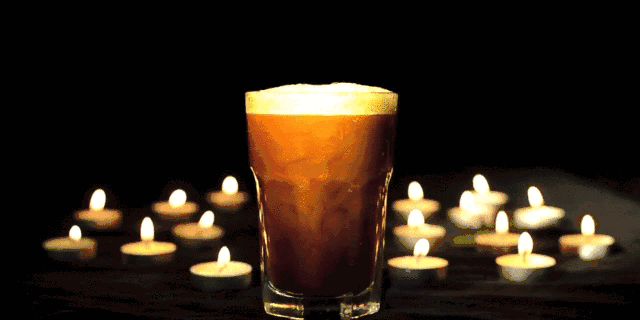Five development trends of coffee and tea industry

Coffee and tea is a growth segment of the catering industry. Sales in coffee shops alone reached $21.6 billion in 2016. Even so, the market is facing fierce competition from retail products, especially the fast-growing ready-to-drink coffee. Even with the challenges, coffee shops are still one step ahead by offering innovative drinks to consumers. Industry insiders estimate that the coffee and tea industry will show five major development trends in the future.
Nitrogen coffee
2017 may be the year of the outbreak of nitrogen coffee. Nitrogen coffee is made by adding nitrogen to cold coffee to make the drink have a naturally emulsified and smooth taste. Coffee connoisseurs may already be familiar with nitrogen coffee, as the drink has appeared in some third-wave cafes in the past few years and has been available in ready-to-drink versions. Nowadays, many coffee companies in the United States have launched nitrogen coffee, such as almond milk ready-to-drink nitrogen coffee series. In the future, more brands will launch nitrogen coffee.
New product of coffee pulp
Consumers are increasingly concerned about food waste and chefs are looking for ways to reuse ingredients to reduce overall waste, according to the Mintel Food and Beverage Trends 2017: reduce, reuse and transform. Coffee and tea drinks with coffee pulp are in line with this trend. This is a sour and bitter caffeine drink made from discarded coffee pulp. Although they are still relatively niche drinks, the use of coffee pulp is increasing. For example, a coffee shop in the United States launched a drink made from a mixture of coffee pulp and butter. Starbucks has also begun to attach importance to coffee pulp. Not long ago, at its twice-yearly investor meetings, Starbucks announced that it would launch a coffee pulp latte.
New trend of Coffee processing
Over the past decade, it has been characterized by the rise of a third wave of coffee shops, which focuses on where coffee comes from and how it is prepared. It is clear that this trend will continue, but at the same time more and more coffee shops are beginning to focus on the coffee processing process-from harvesting coffee beans to grinding into coffee powder. Many companies in the United States have begun to store coffee in wooden buckets for a long time to give it a completely different new flavor.
Some brands emphasize the common fermentation steps in coffee processing. It is too early to tell whether these practices will become a new wave, but more companies are expected to promote their distinctive processing methods. Of all the emerging processing technologies, "aged" coffee is probably the most popular among consumers, with 1 gamble and 4% of American consumers saying they are willing to try aged coffee in restaurants.
Alcoholic drinks from coffee shops
The Mintel survey found that 22-year-old 34-year-old consumers of 1Compact 3 would like to see more coffee shops offering alcoholic drinks in 2017. Although the pairing of wine and coffee is not a new idea, bars have already added coffee to their cocktails in fresh and interesting ways, but it is really worth looking forward to when coffee shops launch alcoholic drinks. As bartenders use more coffee, coffee cocktails become more and more complex. For example, a coffee shop in Denver in the United States launched a nitrogen cold Manhattan cocktail containing Brackenridge bourbon, Novala, orange bitters and cold coffee. Coffee wine served in a coffee shop in New York City is made from French brandy, Brazilian rum, fresh Lemon Juice, orange juice, cinnamon and cold coffee.
Functional tea
Nowadays, the consumption is upgrading, the concept of health is changing, and the consumption demand for tea is becoming more and more healthy. it is under this general trend that functional tea begins to cause widespread concern among consumers. Matcha has been widely used in functional tea because of its high content of antioxidants. Turmeric, which became popular in 2016, is now used to make special herbal tea drinks. In addition, kombucha is positioned as an functional drink because of its probiotics.
Important Notice :
前街咖啡 FrontStreet Coffee has moved to new addredd:
FrontStreet Coffee Address: 315,Donghua East Road,GuangZhou
Tel:020 38364473
- Prev

Nitrogen drinks cool techs MORNINGBEER-- nitrogen Coffee Weather Vane
Nitro + Coffee 2017 from Brewista Pictures from the network Starbucks, the new darling of the global coffee industry, is a powerful push. Guinness is the enlightenment of nitrogen coffee. Since 2016, Starbucks, a coffee giant sweeping the world in the form of chain stores, has announced the addition of cold coffee and the launch of nitrogen coffee.
- Next

A mobile phone pours out a good cup of coffee
Nowadays, more and more people like to drink coffee, and the demand for the quality of coffee is higher and higher. Especially for people who like to stay at home, how to drink delicious coffee most conveniently has become a great demand for them. It was with this in mind that RoderickdeRode designed the Spinn intelligent coffee machine. Spinn, which made its debut last year, is the world's first smart centrifugal brewing coffee.
Related
- What effect does Italian American coffee with filter paper have? Will coffee taste better if it is put on filter paper at the bottom of the powder bowl?
- What is the color difference in coffee beans? What are the characteristics of honey processed coffee beans? Why are the anaerobically treated coffee beans uneven in color?
- How does novice Xiaobai quickly get started and make coffee? Newbies learn to make coffee by hand and share the specific steps and process process!
- Costa tea has a shelf life of 100 years?! Expert: Unable to verify
- It's a huge uproar! American milk addition was rejected by Manner employees?!
- Mocha pot coffee bean recommendations| How fine and how much powder should be used for grinding? What parameter ratios do I need to use to make milk with Mocha pot coffee?
- What are the characteristics of the world's top ten coffee beans treated with Costa Rica honey? How to make black honey kadura from Tarazhu Pilon Processing Plant taste good?
- How to make deep-roasted coffee? What grinding water temperature does authentic Jamaica Blue Mountain No. 1 coffee use to brew it well?
- Selected high-grade rose summer coffee flavor tasting guide Why Panama rose summer has the aroma of flowers and fruits
- What equipment does a novice Xiaobai need to buy to learn to make coffee? Filter cup electronic scale bean grinder manual flushing pot purchase guide

